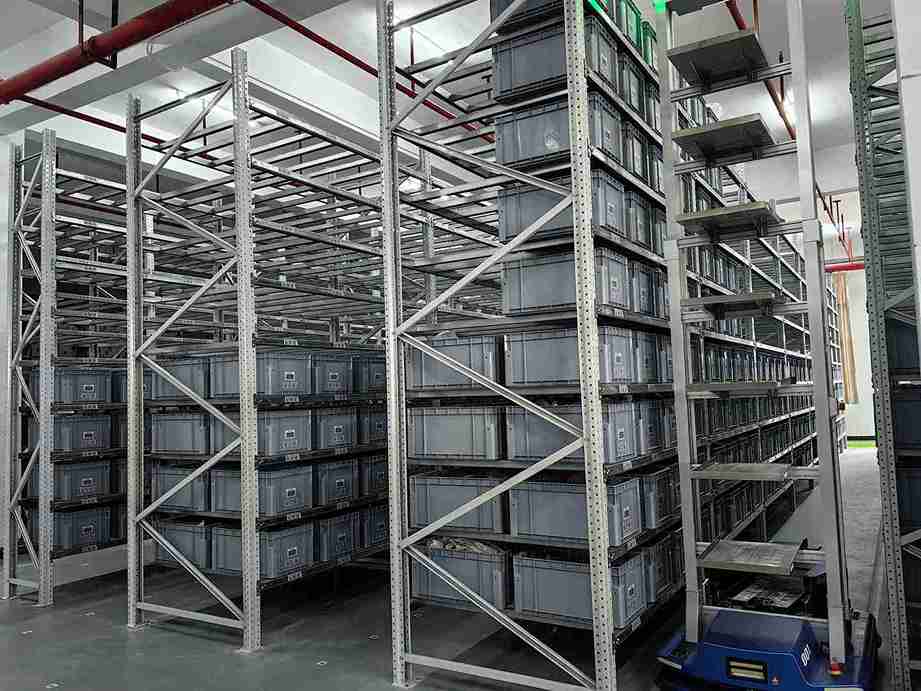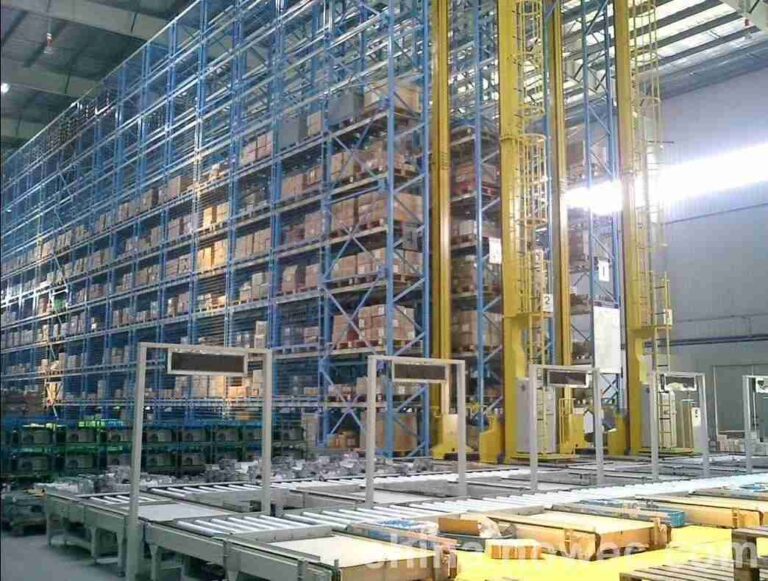📐 "First 50 Enterprise Queries Get Custom 3D Warehouse Design" Plan

The Critical Role of AGV Racking in Modern Warehousing
Automated Guided Vehicles (AGVs) are revolutionizing warehouses, but their true potential can only be unlocked with the right AGV racking system. Unlike traditional storage solutions, AGV-compatible racking is engineered for precision, durability, and seamless automation integration.
A poorly designed AGV racking system can lead to:
-
Navigation errors, causing AGVs to misalign or collide
-
Inefficient storage, reducing warehouse throughput
-
Higher operational costs due to maintenance and downtime
This guide dives deep into AGV racking, covering:
✔ Key design considerations for automation compatibility
✔ Cost comparisons between different AGV racking types
✔ Real-world case studies of successful implementations
✔ Common mistakes and how to avoid them
By the end, warehouse operators will know exactly how to select, install, and optimize AGV racking for maximum efficiency.

1. What Makes AGV Racking Different from Standard Warehouse Racking?
Not all racking systems work well with AGVs. Traditional pallet racks were designed for human-operated forklifts, whereas AGV racking must accommodate robotic precision, consistent load handling, and tight navigation tolerances.
1.1. Precision Alignment: Why Standard Racking Fails AGVs
AGVs rely on laser guidance, magnetic tapes, or vision systems to navigate. If racking is even slightly misaligned:
-
AGVs may misplace pallets, leading to inventory errors
-
Fork collisions can damage both the rack and the AGV
-
Operational slowdowns occur as AGVs readjust paths
Solution:
-
Laser-leveled rack installation ensures perfect alignment
-
Adjustable baseplates allow fine-tuning as needed
1.2. Load Stability: Preventing Shifts During Robotic Handling
Unlike human operators, AGVs cannot make real-time adjustments if a pallet shifts. Poorly designed AGV racking can result in:
-
Pallets tipping during retrieval
-
AGV forks slipping, causing product damage
-
Uneven weight distribution, increasing wear on AGV mechanisms
Solution:
-
Anti-slip decking keeps pallets secure
-
Reinforced uprights prevent sway under heavy loads
1.3. Clearance & Maneuverability: Avoiding AGV Traffic Jams
AGVs require consistent aisle widths and turning radii. If AGV racking isn’t optimized:
-
Bottlenecks form in high-traffic zones
-
AGVs get stuck, reducing throughput
-
Collisions with racking columns increase maintenance costs
Solution:
-
Narrow-aisle (NA) racking for tighter AGV navigation
-
Mobile racking systems that adjust to AGV pathways
2. The Best AGV Racking Systems for Automated Warehouses
Not all racking is equally suited for AGV integration. Below are the top AGV racking options, ranked by automation compatibility.
2.1. Selective Pallet Racking (The Most AGV-Friendly Option)
-
Best for: Warehouses with medium-to-high SKU variety
-
AGV Compatibility: ⭐⭐⭐⭐⭐ (Highest)
-
Average Cost: $50–$150 per pallet position
Why It Works for AGVs:
✔ Adjustable beam heights allow customization for different AGV fork types
✔ Open design minimizes navigation interference
✔ Easy to integrate with Warehouse Management Systems (WMS)
Limitations:
✖ Requires precise alignment to avoid AGV misplacement
✖ May need additional safety sensors for high-speed AGVs
2.2. Drive-In/Drive-Through Racking (For High-Density AGV Storage)
-
Best for: FIFO or LIFO inventory (e.g., food, chemicals)
-
AGV Compatibility: ⭐⭐⭐ (Moderate)
-
Average Cost: $200–$400 per pallet position
Why It Works for AGVs:
✔ Maximizes storage density, reducing warehouse footprint
✔ Works well with specialized AGVs designed for deep storage
Limitations:
✖ Slower retrieval times due to depth
✖ Not ideal for mixed SKUs (better for bulk storage)
2.3. Push-Back Racking (For Semi-Automated AGV Workflows)
-
Best for: High-density storage with medium turnover
-
AGV Compatibility: ⭐⭐⭐⭐ (High)
-
Average Cost: $150–$300 per pallet position
Why It Works for AGVs:
✔ Dynamic storage reduces AGV travel time
✔ Gravity-fed system minimizes AGV handling errors
Limitations:
✖ Higher upfront cost than selective racking
✖ Requires AGVs with precise depth control
3. Key Factors When Choosing AGV Racking
Selecting the right AGV racking involves more than just storage capacity. Below are the most critical factors to consider.
3.1. AGV Forklift Type & Load Capacity
-
Standard AGV Forks: Need 6–8 ft aisles
-
Narrow-Aisle AGVs: Operate in 5–6 ft aisles
-
Heavy-Duty AGVs (3,000+ lbs): Require reinforced beams
3.2. Warehouse Layout & Future Scalability
-
Fixed Racking: Lower cost but inflexible
-
Mobile Racking: Adjustable but more expensive
-
Modular Designs: Best for expanding automation
3.3. Software Integration (WMS + AGV Control Systems)
-
Real-time tracking prevents mis-picks
-
Automated replenishment reduces AGV idle time
4. AGV Racking Cost Analysis: Is Automation Worth the Investment?
| Racking Type | Avg. Cost per Pallet Position | AGV Compatibility | Expected Lifespan |
|---|---|---|---|
| Selective Pallet Racking | $50–$150 | ⭐⭐⭐⭐⭐ | 15–20 years |
| Drive-In Racking | $200–$400 | ⭐⭐⭐ | 20–25 years |
| Push-Back Racking | $150–$300 | ⭐⭐⭐⭐ | 15–20 years |
| Automated AS/RS | $500–$1,000+ | ⭐⭐⭐⭐⭐ | 25+ years |
Key Takeaway: While AGV racking has a higher upfront cost than traditional systems, it reduces labor expenses, minimizes errors, and boosts efficiency by 30–50%.
5. Common AGV Racking Mistakes (And How to Avoid Them)
❌ Ignoring AGV Turning Radius → Results in collisions and downtime
❌ Choosing Weak Beams for Heavy Loads → Leads to structural failures
❌ Skipping Load Testing → Causes AGV misalignment during operation
6. Case Study: How [Company X] Increased Efficiency by 40% with AGV Racking
-
Before: Manual forklifts + standard racking → 80 picks/hour
-
After: AGVs + optimized AGV racking → 112 picks/hour
-
ROI Achieved: 2.5 years
7. Conclusion: Choosing the Right AGV Racking for Long-Term Success
Selecting the best AGV racking system is a strategic decision that impacts warehouse efficiency, safety, and ROI. The ideal choice depends on:
✔ AGV type and navigation system
✔ Warehouse layout and storage needs
✔ Budget and scalability requirements
Next Steps for Warehouse Managers:
-
Conduct an AGV compatibility audit of existing racking
-
Consult an automation specialist for a customized solution
-
Test different configurations before full-scale deployment
FAQs About AGV Racking
1. Can existing racking be modified for AGVs?
Yes, but modifications may include beam reinforcement, safety sensors, and AGV recalibration.
2. What’s the minimum aisle width for racking?
-
Standard AGVs: 6–8 ft
-
Narrow-Aisle AGVs: 5–6 ft
3. How do AGVs handle uneven pallet loads?
Advanced AGVs use weight sensors & auto-balancing forks to prevent drops.
4. Does AGV racking require special flooring?
Yes, flat, reinforced concrete is essential for accurate AGV navigation.
5. What’s the typical lifespan of AGV-compatible racking?
15–25 years, depending on maintenance and load capacity.
Welcome to contact us, if you need warehouse rack CAD drawings. We can provide you with warehouse rack planning and design for free. Our email address is: jili@geelyracks.com




